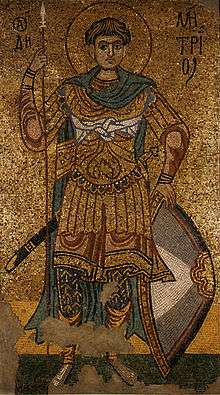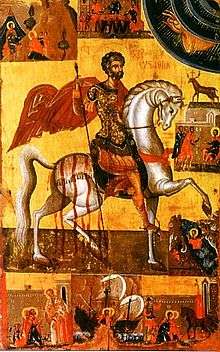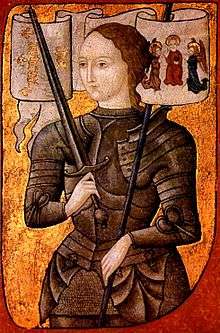Military saint

The military saints or warrior saints (also called soldier saints) of the Early Christian Church are Christian saints who were soldiers in the Roman Army during the persecution of Christians, especially the Diocletian persecution of AD 303–313.
Most of these saints are martyrs, soldiers of the Empire who had become a Christian and refusing to participate in rituals of loyalty to the Emperor (see Imperial cult), subjected to corporal punishment that escalates to torture and eventually martyred.
The characteristic of the military saints is their depiction as soldiers in traditional Byzantine iconography from about the 10th century (Macedonian dynasty) and especially also in Slavic Christianity.[1] While early icons showed the saints in "classicizing" attire, icons from the 11th, and especially from the 12th century, painted in the new style of τύπων μιμήματα, i.e. imitating nature, are an important source for Byzantine military equipment of the medieval period.[2]
Veneration of these saints, most notably of Saint George, also entered Western tradition during the time of the Crusades.
The title of "champion of Christ" (athleta Christi) was originally used for these saints, but in the late medieval period also conferred on contemporary rulers by the Pope.
Significance
In Late Antiquity other Christian writers of hagiography, like Sulpicius Severus in his account of the heroic, military life of Martin of Tours, created a literary model that reflected the new spiritual, political, and social ideals of a post-Roman society. In a study of Anglo-Saxon soldier saints (Damon 2003), J.E. Damon has demonstrated the persistence of Sulpicius's literary model in the transformation of the pious, peaceful saints and willing martyrs of late antique hagiography to the Christian heroes of the early Middle Ages, who appealed to the newly converted societies led by professional warriors and who exemplified accommodation with and eventually active participation in holy wars that were considered just.[3] A similar development in the cult of Saint Demetrius of Thessaloniki has been observed; although always described as a soldier, depictions of him were in civilian dress for centuries until around the turn of the millennium, after which he is nearly always shown fully armed.
The angelic prototype of the Christian soldier-saint is the Archangel Michael, whose earliest known cultus began in the 5th century with a shrine at Monte Gargano. The cult of soldier-saints followed the transformation of Michael into a Christian figure.
The Orthodox military saints are on the whole more prominent in the respective devotions of their churches than the Catholic ones, especially as the military crisis of the Byzantine Empire deepened. They are usually shown fully equipped for fighting, unlike many Catholic military saints. The most important are Saint George, Saint Demetrius of Thessaloniki (these two very often paired, riding on horseback or on foot in icons), Saint Theodore the General, and Saint Theodore the Recruit. It is noticeable that a historical basis for all of these is essentially lacking.
Of these St George was imported to the West during the period of the Crusades.
List of military saints
| Image | Name | Martyrdom | Location | Veneration | Notes |
|---|---|---|---|---|---|
| Acacius | c. 303 | Byzantium | |||
| Andrew the General | c. 300 | Cilicia | |||
 |
Demetrius of Thessaloniki | 304 | Sirmium | ||
| Emeterius and Chelidonius | c. 300 | Calagurris in Hispania Tarraconensis | |||
 | Eustace | ||||
| Florian | c. 303 | Lauriacum in Noricum | |||
 |
George | c. 303 | Nicomedia in Bithynia | ||
 | Gereon | Catholic Church | |||
 | Joan of Arc | Catholic Church | |||
 |
Maurice and the Theban Legion | 287 | Agaunum in Alpes Poeninae et Graiae | Catholic Church | |
 |
Martin of Tours | Catholic Church | |||
| Maximilian | 295 | Tebessa in Africa Pronsularis | |||
| Marcellus of Tangier | 298 | Tingis in Mauretania Tingitana | |||
| |
Menas | c. 309 | Cotyaeum in Phrygia | ||
| Mercurius | 250 | Caesarea in Cappadocia | |||
| Sergius and Bacchus | c. 305 | Resafa and Barbalissus in Syria Euphratensis | |||
| Theodore of Amasea | 306 | Amasea in Helenopontus | |||
| Typasius the Veteran | 304 | Tigava in Mauretania Caesariensis | |||
| Varus | c. 307 | Egypt | |||
| Victor the Moor | c. 303 | Milan in Italy | |||
.jpg) |
Nicetas the Goth | 372 | Dacia | ||
| Forty Martyrs of Sebaste | 320 | Sebaste | |||
See also
| Wikimedia Commons has media related to military saints. |
- Christians in the military
- Patron saints of the military
- Saint George: Devotions, traditions and prayers
- Military ordinariate
- Military order (monastic society)
References
- ↑ "The 'warrior saints' or 'military saints' can be distinguished from the huge host of martyrs by the pictorial convention of cladding them in military attire." (Grotowski 2010:2)
- ↑ (Grotowski 2010:400)
- ↑ Damon, John Edward. Soldier Saints and Holy Warriors: Warfare and Sanctity in the Literature of Early England. (Burlington (VT): Ashgate Publishing Company), 2003, ISBN 0-7546-0473-X
- Monica White, Military Saints in Byzantium and Rus, 900–1200 (2013).
- Christopher Walter, The Warrior Saints in Byzantine Art and Tradition (2003).
- Piotr Grotowski, Arms and Armour of the Warrior Saints: Tradition and Innovation in Byzantine Iconography (843–1261), Volume 87 of The Medieval Mediterranean (2010).
_2.jpg)